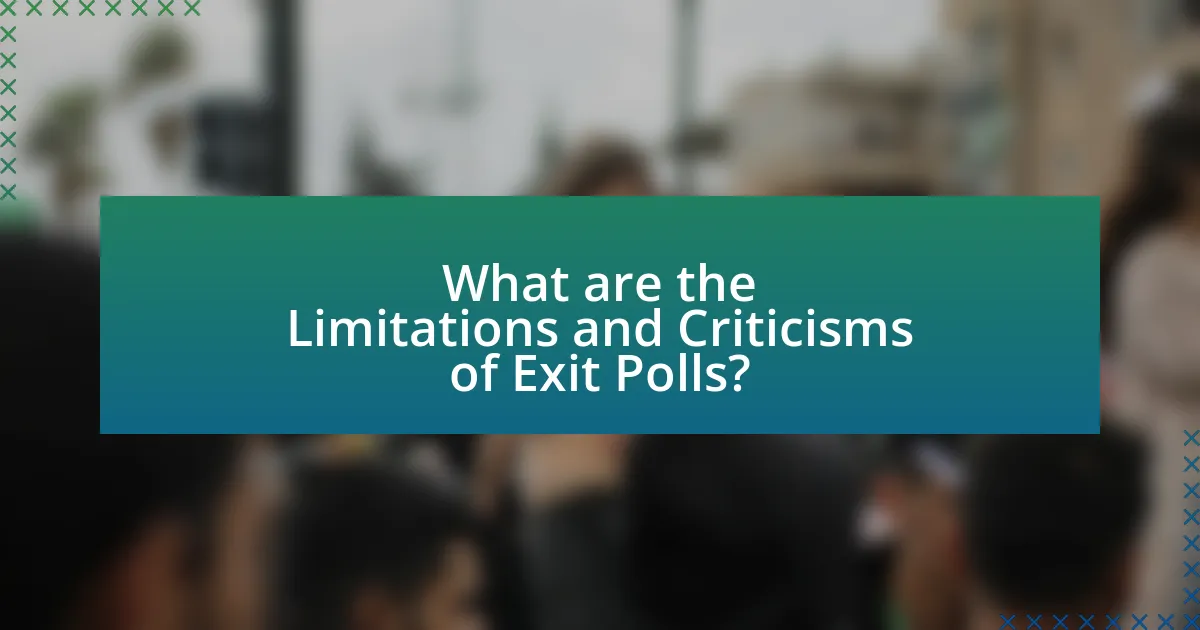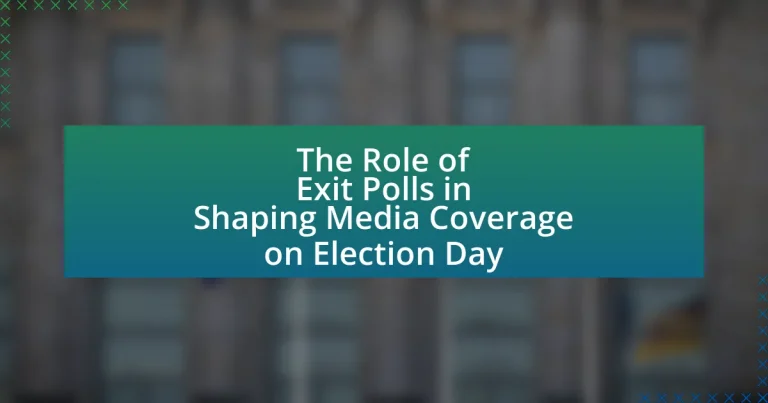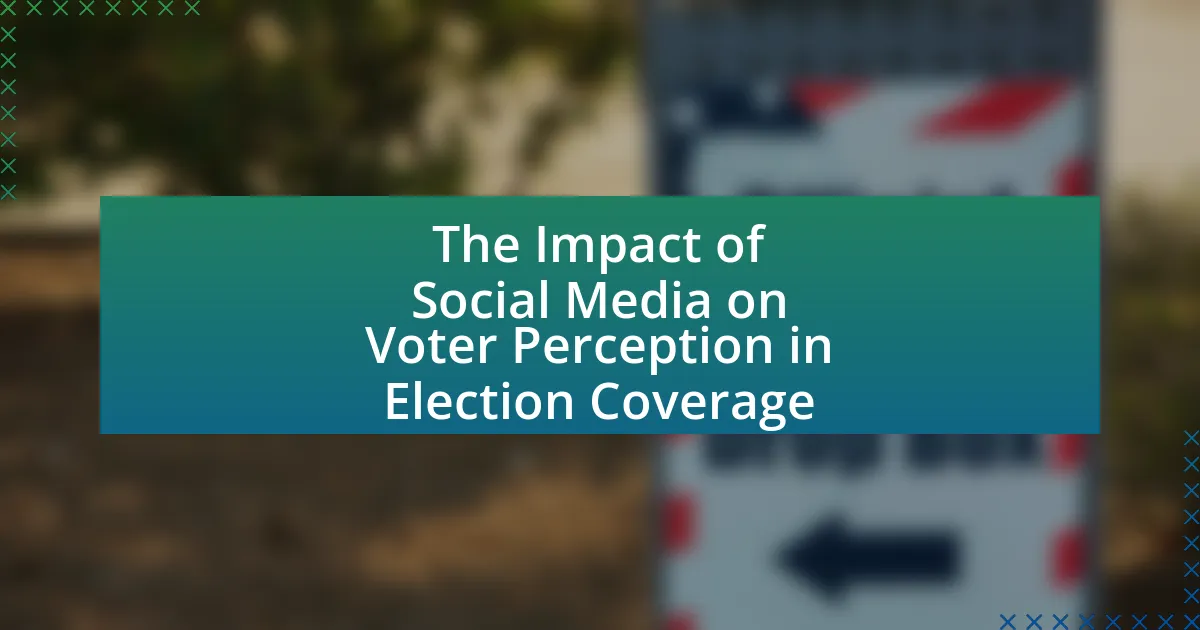Exit polls are surveys conducted with voters immediately after they cast their ballots, serving to predict election outcomes and analyze voter behavior. This article examines the methodologies behind exit polling, the demographics of participants, and the significance of these polls in shaping media narratives and public perception on Election Day. It highlights the importance of accurate representation and the challenges faced by media when reporting exit poll results, as well as the psychological effects these polls can have on voter behavior. Additionally, the article discusses the evolution of exit polling practices and the best practices media should follow to ensure reliable reporting.

What are Exit Polls and Their Purpose on Election Day?
Exit polls are surveys conducted with voters immediately after they have cast their ballots, aimed at predicting election outcomes and understanding voter behavior. The primary purpose of exit polls on Election Day is to provide early insights into how different demographic groups voted, which can help media outlets project winners and analyze trends. For instance, during the 2020 U.S. presidential election, exit polls indicated significant shifts in voting patterns among various age and racial groups, influencing media narratives and public perception of the election results.
How are Exit Polls Conducted?
Exit polls are conducted by surveying voters immediately after they leave polling places. Pollsters typically select a sample of voters from various locations and ask them about their voting choices and demographic information. This method allows for the collection of data that can predict election outcomes and analyze voter behavior. According to the National Election Pool, exit polls are designed to be representative of the electorate, using stratified sampling techniques to ensure diverse demographic representation.
What methodologies are used in Exit Polling?
Exit polling methodologies primarily involve surveying voters as they leave polling places to gather data on their voting behavior and demographics. These methodologies typically include random sampling, where a representative sample of voters is selected to ensure diverse demographic representation, and structured questionnaires that ask about candidate preferences and reasons for voting choices. Additionally, exit polls often utilize stratified sampling techniques to ensure that various demographic groups, such as age, gender, and ethnicity, are accurately represented, enhancing the reliability of the results. According to the National Election Pool, which conducts exit polls for major media organizations, these methodologies are crucial for providing timely and accurate insights into voter behavior on election day.
Who are the participants in Exit Polls?
Participants in exit polls are voters who have just cast their ballots in an election. These individuals are typically approached by pollsters outside polling places immediately after voting. The purpose of their participation is to provide insights into voting behavior, preferences, and demographic information, which can be analyzed to predict election outcomes. According to the National Election Pool, exit polls are conducted to gather data that reflects the electorate’s choices and motivations, thus influencing media coverage and public perception on election day.
Why are Exit Polls Important for Media Coverage?
Exit polls are important for media coverage because they provide immediate insights into voter behavior and preferences right after they cast their ballots. These polls help journalists and analysts gauge the outcome of elections before official results are available, allowing for timely reporting and analysis. For instance, during the 2008 U.S. presidential election, exit polls indicated that Barack Obama would win, which shaped media narratives and public expectations even before the final vote counts were released. This early information can influence voter perceptions and political discussions, making exit polls a critical tool for media outlets on election day.
How do Exit Polls influence public perception of election outcomes?
Exit polls significantly influence public perception of election outcomes by providing immediate insights into voter behavior and preferences. These polls, conducted as voters leave polling places, offer early indicators of which candidates may win, shaping narratives in media coverage and public discourse. For instance, in the 2004 U.S. presidential election, exit polls suggested John Kerry was leading, which led to heightened expectations among his supporters, despite George W. Bush ultimately winning the election. This discrepancy illustrates how exit polls can create a perception of momentum or inevitability that may not reflect actual results, impacting voter sentiment and engagement.
What role do Exit Polls play in shaping narratives on Election Day?
Exit polls play a critical role in shaping narratives on Election Day by providing early insights into voter preferences and behaviors. These polls, conducted as voters leave polling places, offer immediate data that can influence media coverage and public perception of the election outcome. For instance, in the 2000 U.S. presidential election, exit polls indicated a strong lead for Al Gore, which shifted media narratives until the actual results revealed George W. Bush’s victory. This demonstrates how exit polls can create expectations that may not align with final results, impacting voter sentiment and media framing throughout the day.

How Do Exit Polls Affect Media Reporting?
Exit polls significantly influence media reporting by providing early insights into voter preferences and potential election outcomes. Media outlets utilize these polls to shape their narratives and inform the public about trends before official results are available. For instance, during the 2004 U.S. presidential election, exit polls indicated a strong lead for John Kerry, which led many media organizations to project his victory early, despite George W. Bush ultimately winning. This demonstrates how exit polls can create expectations and influence public perception, often leading to immediate analysis and commentary that may not align with final results.
What are the implications of Exit Poll results for news coverage?
Exit poll results significantly influence news coverage by shaping narratives and guiding reporting on election outcomes. Media outlets often rely on these polls to provide immediate insights into voter behavior and preferences, which can affect public perception and voter turnout. For instance, during the 2008 U.S. presidential election, exit polls indicated a strong lead for Barack Obama, prompting extensive coverage that framed the election as a pivotal moment in American history. This reliance on exit polls can lead to premature conclusions about election results, as seen in the 2000 election when early projections based on exit polls misled viewers before the final count was completed. Thus, exit poll results serve as a critical tool for news organizations, impacting both the framing of stories and the overall narrative surrounding an election.
How do journalists interpret Exit Poll data?
Journalists interpret exit poll data as a crucial tool for understanding voter behavior and predicting election outcomes. They analyze the demographic breakdown of respondents, such as age, gender, and ethnicity, to identify trends and shifts in voter preferences. For instance, in the 2020 U.S. presidential election, exit polls indicated that 55% of women voted for Joe Biden, compared to 43% for Donald Trump, highlighting significant gender-based voting patterns. Journalists use this information to provide context and depth to their election coverage, often comparing exit poll results with previous elections to assess changes in voter sentiment. This interpretation helps shape narratives and informs the public about potential implications for future political landscapes.
What challenges do media face when reporting Exit Poll results?
Media face several challenges when reporting exit poll results, primarily related to accuracy, timing, and interpretation. The accuracy of exit polls can be compromised by factors such as non-response bias, where certain demographics may be underrepresented, leading to skewed results. Timing poses another challenge, as media outlets must balance the need to report results promptly with the risk of disseminating potentially misleading information before all votes are counted. Additionally, interpreting exit poll data can be complex; media must convey nuanced findings to the public without oversimplifying or misrepresenting the implications of the data. These challenges are underscored by instances where early exit poll projections have led to significant public confusion or misinterpretation of election outcomes.
How do Exit Polls impact voter behavior and expectations?
Exit polls significantly influence voter behavior and expectations by providing immediate insights into voter preferences and anticipated election outcomes. These polls can create a bandwagon effect, where voters may feel compelled to support a candidate perceived as likely to win, based on early exit poll results. For instance, in the 2004 U.S. presidential election, early exit polls indicated a strong lead for John Kerry, which led some voters to shift their support, believing he would win. Additionally, exit polls can shape media narratives, impacting voter turnout and engagement by either energizing supporters of leading candidates or demoralizing those trailing. This dynamic was evident in the 2016 election, where conflicting exit poll data contributed to varying expectations among voters, ultimately affecting their participation.
What psychological effects do Exit Polls have on voters?
Exit polls can significantly influence voters’ psychological states by creating a sense of validation or disillusionment based on projected outcomes. When exit polls indicate a strong lead for a candidate, supporters may feel a heightened sense of confidence and enthusiasm, potentially increasing voter turnout. Conversely, if exit polls suggest a loss for a favored candidate, it can lead to feelings of hopelessness or disengagement, which may discourage voters from participating in the election. Research has shown that the framing of exit poll results can shape public perception and emotional responses, impacting the overall electoral process. For instance, a study by the Pew Research Center found that voters exposed to favorable exit poll results were more likely to report feeling motivated to vote, while those confronted with unfavorable results expressed lower motivation levels.
How do Exit Polls shape the narrative before official results are announced?
Exit polls shape the narrative before official results are announced by providing early insights into voter preferences and behaviors. These polls, conducted as voters leave polling places, offer a snapshot of the electorate’s choices, which media outlets use to project potential outcomes and influence public perception. For instance, during the 2004 U.S. presidential election, exit polls indicated a close race, leading to significant media coverage that framed the election as highly competitive, despite official results later showing a clearer victory for George W. Bush. This early information can create momentum for candidates and affect voter turnout, as supporters may feel encouraged or discouraged based on the projected outcomes.

What are the Limitations and Criticisms of Exit Polls?
Exit polls have several limitations and criticisms, primarily related to their accuracy and methodology. One significant limitation is that exit polls often rely on a sample of voters that may not be representative of the overall electorate, leading to biased results. For instance, in the 2000 U.S. presidential election, exit polls underestimated George W. Bush’s support among certain demographics, which contributed to misleading projections. Additionally, the timing of exit polls can affect their reliability; results are typically reported before all votes are counted, which can lead to premature conclusions. Critics also point out that respondents may not accurately recall their voting choices or may provide socially desirable answers, further skewing the data. Furthermore, the increasing use of early voting complicates the traditional exit poll model, as it does not capture the preferences of those who vote before Election Day. These factors collectively undermine the credibility of exit polls as definitive indicators of election outcomes.
What are the common criticisms of Exit Poll methodologies?
Common criticisms of exit poll methodologies include issues of representativeness, accuracy, and potential bias. Critics argue that exit polls may not accurately reflect the voting population due to sampling errors, as they often rely on a limited number of respondents who may not represent the broader electorate. For instance, a study by the American Association for Public Opinion Research highlighted that demographic discrepancies, such as underrepresentation of certain age groups or ethnicities, can skew results. Additionally, the timing of the polls can lead to inaccuracies, as voters may change their preferences after casting their ballots. Furthermore, the methodology can be influenced by the interviewers’ biases, which may affect how questions are posed and interpreted. These factors collectively raise concerns about the reliability of exit polls in providing an accurate snapshot of election outcomes.
How can biases affect Exit Poll results?
Biases can significantly distort Exit Poll results by influencing the selection of respondents and the interpretation of data. For instance, if pollsters predominantly survey voters in specific demographics, such as urban areas, the results may not accurately reflect the broader electorate’s preferences. Research has shown that biases in sampling can lead to overrepresentation or underrepresentation of certain groups, which skews the overall findings. A notable example occurred in the 2004 U.S. presidential election, where exit polls underestimated George W. Bush’s support among rural voters, leading to misleading projections. This illustrates how biases can misinform media coverage and public perception on election day.
What factors can lead to inaccuracies in Exit Polls?
Inaccuracies in exit polls can arise from several factors, including sampling errors, respondent bias, and timing of data collection. Sampling errors occur when the selected sample does not accurately represent the overall voting population, leading to skewed results. Respondent bias can happen if individuals are reluctant to disclose their true voting intentions or if they misrepresent their choices, often influenced by social desirability. Additionally, the timing of data collection can affect accuracy; if polls are conducted too early or too late, they may not capture the final voting trends. Historical instances, such as the 2000 U.S. presidential election, illustrate how these factors can lead to significant discrepancies between exit poll predictions and actual election outcomes.
How have Exit Polls evolved over time?
Exit polls have evolved significantly over time, transitioning from simple surveys to sophisticated data collection methods. Initially, exit polls were conducted manually, relying on a small number of interviewers at polling places to gather voter opinions immediately after casting their ballots. Over the years, advancements in technology have enabled the use of larger sample sizes and more complex statistical techniques, improving the accuracy and reliability of the results. For instance, in the 1980s, the National Election Pool was established, allowing major news organizations to collaborate on exit polling, which enhanced data consistency and coverage across various regions. Additionally, the rise of digital platforms has facilitated real-time data analysis, allowing media outlets to report findings more quickly and accurately on election day. This evolution reflects a broader trend towards data-driven decision-making in journalism, underscoring the critical role exit polls play in shaping media narratives during elections.
What technological advancements have influenced Exit Polling?
Technological advancements such as digital data collection, mobile polling applications, and sophisticated statistical modeling have significantly influenced exit polling. Digital data collection allows for real-time aggregation of voter responses, enhancing the speed and accuracy of results. Mobile polling applications enable pollsters to reach a broader demographic by facilitating immediate feedback from voters at polling stations. Additionally, advanced statistical modeling techniques improve the reliability of predictions by analyzing complex datasets, including demographic information and historical voting patterns. These innovations have transformed exit polling into a more efficient and precise tool for gauging voter sentiment on election day.
How have changes in voter demographics affected Exit Polls?
Changes in voter demographics have significantly impacted exit polls by altering the accuracy and representation of polling data. As the electorate becomes more diverse, including shifts in age, race, and educational attainment, exit polls must adapt to capture these variations accurately. For instance, the 2020 U.S. presidential election exit polls indicated that 50% of voters were non-white, a notable increase from previous elections, which necessitated adjustments in polling methodologies to ensure that these groups were adequately represented. This shift has led to more nuanced insights into voter behavior and preferences, influencing media narratives and coverage on election day.
What Best Practices Should Media Follow When Reporting Exit Polls?
Media should ensure accuracy, transparency, and context when reporting exit polls. Accurate reporting involves using reliable methodologies and clearly stating the sample size and margin of error, as these factors significantly influence the credibility of the results. Transparency requires media outlets to disclose the sources of their exit poll data and the timing of the polls, allowing audiences to understand the context in which the information is presented. Providing context means explaining how exit polls fit into the broader electoral landscape, including potential biases and the limitations of the data. For instance, the National Election Pool, which conducts exit polls for major news organizations, emphasizes the importance of these practices to maintain public trust and avoid misinterpretation of the results.
How can media ensure accurate representation of Exit Poll data?
Media can ensure accurate representation of Exit Poll data by employing rigorous methodologies and transparent reporting practices. This includes utilizing a scientifically valid sampling technique to gather data from a diverse and representative group of voters, which minimizes bias. For instance, the National Election Pool, which conducts exit polls for major news organizations, employs a stratified sampling method to ensure that demographics such as age, race, and geography are proportionately represented. Additionally, media outlets should clearly communicate the margin of error and the confidence level associated with the exit poll results, allowing audiences to understand the reliability of the data. By adhering to these practices, media can enhance the credibility of their reporting on election outcomes.
What strategies can journalists use to communicate Exit Poll findings effectively?
Journalists can effectively communicate Exit Poll findings by utilizing clear and concise language, visual aids, and contextual analysis. Clear language ensures that the findings are easily understood by the audience, while visual aids such as graphs and charts can help illustrate trends and comparisons, making the data more accessible. Contextual analysis provides background information on the significance of the findings, helping the audience understand how the results relate to broader electoral trends or historical data. For instance, a study by the Pew Research Center highlights that visual representations of data significantly enhance audience comprehension and retention, demonstrating the effectiveness of these strategies in media reporting.




